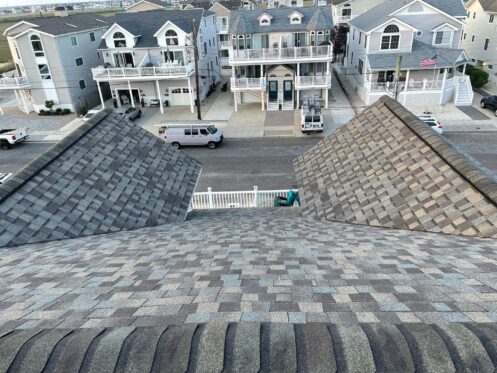A roof warranty acts as added protection for your home. Woodbine and other areas of Southern Jersey have some rough winters and equally rough summers. You never know when an ice dam might form that causes your gutters to come down in the middle of winter or when a sudden storm might carry away some of your shingles. Your warranty lets you get the essential repairs you need. Learn how to check if your home has a warranty and what it covers.
What is a Roof Warranty?
You get a warranty when you hire a company to install a new roof on your home. A roof warranty is essentially a type of insurance just for your roof. You can file a claim when the shingles or other parts suffer damage that the plan covers. Even if you buy an older home with a new roof, you get the same protection. The owner who sold the home usually needs to call the company and transfer the warranty into your name, though you may need to call yourself.
Warranty Types
In the same way that you can buy different types of insurance for your home, you can also get different types of warranties. It usually comes from the manufacturer that made the shingles, underlayment, or other parts. A No Dollar Limit Warranty is the best type but costs more than other warranties. You might find that some manufacturers do not offer this plan because it costs them more in the long run. As the name implies, a No Dollar Limit Warranty has no limit on the amount the manufacturer will pay for your new roof. It can pay for anything your roof needs and an entire roof. Some manufacturers also call this a standard warranty.
A Material Warranty is a more basic type of plan that some manufacturers offer. It only covers any materials that you bought from the manufacturer that were defective. You usually need to prove that the materials failed through no fault on your part. The company will not pay for the labor needed to fix your roof but will pay for new materials. While some plans cover the total cost, others ask you to pay a small fee similar to an insurance co-pay.
You can also opt for a plan called a Manufacturer Labor and Material Warranty. While it covers the same materials as the last option, it also pays for labor. You’ll need to hire a roofing contractor like Jim Rhubart Roofing to handle the repair, but your warranty will pay for the cost we charge. One issue with this type of warranty is that your coverage changes as more time passes. The manufacturer offers less coverage for older homes than newer homes.
The company or contractor you work with can also offer a roofing warranty. One example is a workmanship warranty, which comes directly from them. They agree to cover the cost of any new materials or work you need as long as they made mistakes when installing those products, or they used the wrong materials. With an extended warranty, you get coverage against more things if you agree to pay more.
What Does a Warranty Cover?
Your coverage varies based on the type of warranty you have on your roof. A standard or material warranty only covers the materials used on your roof and only those that came from a specific manufacturer. If you have shingles from one company and an underlayment from another, you may need to file a claim with each one. You usually get full coverage for the first few years and then prorated coverage. During the first years, the company will replace all of the shingles for free. When you reach the prorated phase, the company pays a smaller cost based on your roof’s age.
Most warranty plans will not cover some of the things that can happen to your roof, like ice dams and water damage. They usually don’t pay for shingle damage when you or someone else steps on and breaks them. You often don’t get help to pay for storm or wind damage either. The manufacturer can also void your warranty if it finds that you altered or changed the roof in any way after it was installed.
If you want to protect your investment, opt for an extended roof warranty. This is one of the few plans to pay for damage to your underlayment, which serves as a water barrier between your home and roof. Unlike other plans that limit your coverage as time passes, extended plans usually feature the same amount of coverage for the duration of your plan. Some of the things it will cover include:
- Fasteners
- Cap shingles
- Soffit and fascia boards
- Field shingles
- Ice barriers
How to Check Your Warranty
When you pay a contractor team to install a new roof, you can check the warranty before they begin. You should get a manufacturer warranty from the company that makes the shingles and other components they use. Ask if they also offer a workmanship warranty covering their work. While a manufacturer warranty often lasts for 20 to 30 years or longer, a workmanship warranty may expire after just ten years or less.
It’s not always as easy to find out if you have coverage when you buy a home from another person. Go through all of the paperwork you received at closing. This includes documents from your real estate agent or Realtor and the seller. You can also check with the inspector or appraiser. While an appraiser gives you a home’s value based on its condition and other factors, an inspector provides you with a list of any possible problems with the home. Either one may note that the home has a newer roof and who installed it.
There’s also a chance that the previous owner installed a roof with a valid warranty but never transferred it to your name. You’ll need to find the manufacturer and contact the company for more information. Ask if the roof has a warranty, if it’s still good, and how you can put it in your name. You usually need to provide a copy of the deed or title that shows you as the registered owner. A good seller will handle all of these steps and transfer the warranty to you near the end of the sale.
Talk with some of your neighbors to find out if you have a workmanship warranty. In many areas, neighbors will have new roofs installed by the same company simultaneously. They can give you the name of a local company or a few names you can check. Call each one to see if they installed a roof at your address. Not only can they look this up, but they can also let you know if it’s still valid and what it covers.
Use Your Roof Warranty
Roof repairs can cost $1,000 or more. Installing a new roof can cost ten times that much. With a warranty, you get help to pay for small repairs and cover the cost when you need to replace the entire roof. Call Jim Rhubart Roofing today once you find out if you have a warranty to see if it covers the work you need.






